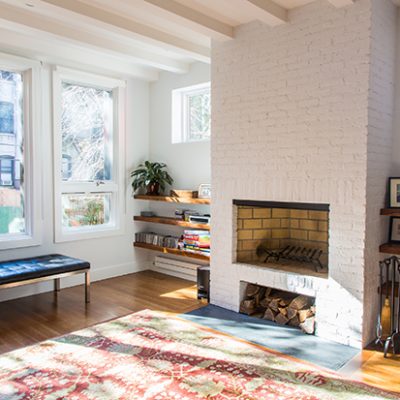
This once near- tear-down-state Park Slope building was renovated in comprehensive and daring style, in part by expanding its gaze to the south
Determining whether to resuscitate a distressed structure or execute a “tear down” is not quite the exercise in pure green visor precision that might be anticipated. The structural integrity of the home has to be assessed, the razing impact on neighboring structures (and neighbors) needs to be determined, and a withering cost-benefit ratio examined. In reviewing the structural integrity of this three-story building at 374 6th Ave. in Park Slope, architect Darrin Krumpus of Boro Archtiects LLC and contractors Red Line Construction determined that a comprehensive rehabilitation of daring scope was in order.
“The house was in terrible condition,” Krumpus recalled. “Only the garden level was being used. The upper two floors had not been occupied in what looked like decades, and the ceilings on the top floor were collapsing from water damage. Plumbing on the top floor wasn’t functional, either.”
After spending a great deal of time with clients in the early stages of design, a plan was developed to turn the structure into a single home of three-level execution. The garden level has a guest room with en-suite bathroom and a large family room that opens to the rear yard; the par- lor floor contains the living room, kitchen, dining room, along with a powder room; while the top floor has three bedrooms, two baths, and a laundry room. This expansive layout would have been impossible given the home’s original footprint of 16′-8″ x 32′, so an 18′ addition to the rear of the building—on all three floors—was completed.
Krumpus and Red Line made a point of taking advantage of the home’s enviable southern exposure, and in both design and construction, allowed as much natural light as possible to flood its center through large windows at the rear.
“The neighbors did not have a rear addition, so we decided to add windows on the side of the new space in order to take advantage of the additional exposure…and capture the view of a very impressive weeping willow tree in a yard a few doors down,” he explained.
After doing major work on more than 30 townhouses in Brooklyn over the last decade, the architect was quick to add that such transformations have yet to become boilerplate, and he wouldn’t have it any other way.
“I’ve come to know these buildings so well and am always delighted to find the differences between them or the little surprises that make each one special,” said Krumpus. “I love the idea that one can take essentially the same building with the same program and make it unique for a client. Seeing these historic houses rejuvenated and adapted individually is wonderfully fulfilling.”









